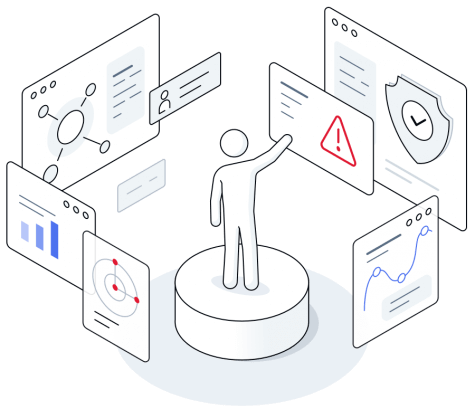Overview
Uncover hidden risks to your data and reputation
With thousands of threats lurking on the dark web, knowing when your business is at risk of attack is a significant challenge. The privacy and anonymity of the dark web makes it an attractive destination for cybercriminals, whether they are looking to trade in stolen credentials, personal information, malware or illicit goods.
Dark web monitoring, a form of digital risk protection, allows organisations to keep a continuous eye on the deep and dark web, including file sharing networks, forums and other communications channels. This helps to increase cyber maturity and aids in the early detection of cyber-attacks. Dark web monitoring also provides valuable insight into adversary tradecraft and vital intelligence to defend against future attacks.
Definition
What is dark web monitoring?
Dark web monitoring is the process of searching for and keeping track of information relating to an organisation’s potential exposures on the deep and dark web. Effective digital risk protection and dark web monitoring services are not one-off exercises, but a continuous process in which a unique set of search criteria are created and regularly updated to defend an organisation’s assets and reputation.
Benefits
Dark web monitoring benefits
The benefits of dark web monitoring services include:
- Identify stolen credentials
- Spot executive of VIP exposures
- Protect brand and reputation
- Manage third-party risks
- Protect staff and customer data
- Keep up with attacker tradecraft
Services
Dark web monitoring services
There are hundreds of thousands of potential threats lurking on the deep and dark web, so it is important to find a dark web monitoring service that is capable of analysing huge volumes of data, but also flexible enough to be adapted to meet your changing needs.
Kroll’s dark web monitoring service uses cutting-edge dark web monitoring tools that ingest terabytes of data every day, with threat intelligence integrations and AI algorithms to filter and prioritise alerts. This data is then triaged and analysed by Kroll’s experienced team of threat intelligence analysts, who provide an exposure report on the risk profile of the organisation, with guidance on the actions needed to address credible threats.
Kroll’s dark web monitoring services are customisable and scalable to meet the needs of your business. If you already have the internal resources to integrate intelligence into security technologies like SIEM and EDR, your requirements can be supported through custom data feeds. Alternatively, customised investigations can be provided to assess internal risk and support M&A activity or active litigation cases.

Why choose Redscan, a Kroll Business?
Why choose Redscan for dark web monitoring?

- Analyst curation of relevant dark web threats generated on client keywords
- Acknowledged experts providing recommended actionable guidance
- Practitioners with years of hands-on industry and US government experience
- Cross reference unique Kroll data collected from our over 3000+ engagements annually
- Regular updates on cross-sector strategic threat intelligence and sector-specific trends
How it works
How dark web monitoring tools work
Dark web monitoring tools work by ingesting large quantities of data and correlating it with a list of keywords to be monitored on a daily basis. This list is optimised over time to support specific monitoring objectives or risk profiles. Common keywords are likely to include:
- Corporate names
- Domain names
- Monikers
- IP addresses
- Watermarks
- Executive names
- Project names
- File hashes
Get a Quote for Dark Web Monitoring
Complete the form for a prompt response from our team.
- A leading global cyber security company
- A deep understanding of how hackers operate
- In-depth threat analysis and advice you can trust
- Multi award-winning offensive security services
- Avg. >9/10 customer satisfaction, 95% retention rate
Resources








